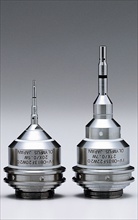Members Login

Channels
Special Offers & Promotions
Olympus MicroProbe Objective lenses for studying biological processes in living animals with minimal surgery
 Olympus today released its unique MicroProbe Objective (MPO) lenses for studying the internal biology of living organisms. The two new water-immersion lenses, namely the 27x magnification IV-OB35F22W20 and the 20x IV-OB13F20W20, have an innovative needle-like design, with the lenses housed in tips measuring 3.5 mm and 1.3 mm in diameter. This means they can be inserted into very small surgical excisions, facilitating in vivo imaging without significantly disrupting the natural state of the tissue or organ being investigated. This approach has a range of applications, from the insertion of the objective into body channels such as the ear or through the body wall via keyhole surgery, to being positioned over small or difficult-to-reach tissues such as the cornea of the eye. The new MPO lenses are also ideal for use in combination with patch clamping and can be employed to produce multi-fluorescence images. Designed to work best in conjunction with laser scanning microscopes such as the Olympus FV1000 or multiphoton systems such as the FV1000MPE, the aptly nicknamed ‘stick lenses' provide an innovative means of investigating biological processes as they occur in the natural in vivo environment of a living animal.
Olympus today released its unique MicroProbe Objective (MPO) lenses for studying the internal biology of living organisms. The two new water-immersion lenses, namely the 27x magnification IV-OB35F22W20 and the 20x IV-OB13F20W20, have an innovative needle-like design, with the lenses housed in tips measuring 3.5 mm and 1.3 mm in diameter. This means they can be inserted into very small surgical excisions, facilitating in vivo imaging without significantly disrupting the natural state of the tissue or organ being investigated. This approach has a range of applications, from the insertion of the objective into body channels such as the ear or through the body wall via keyhole surgery, to being positioned over small or difficult-to-reach tissues such as the cornea of the eye. The new MPO lenses are also ideal for use in combination with patch clamping and can be employed to produce multi-fluorescence images. Designed to work best in conjunction with laser scanning microscopes such as the Olympus FV1000 or multiphoton systems such as the FV1000MPE, the aptly nicknamed ‘stick lenses' provide an innovative means of investigating biological processes as they occur in the natural in vivo environment of a living animal.
The new MPO lenses from Olympus are a completely novel solution for the intravital observation of processes in living organisms. Compared to similar approaches, such as gradient refractive Index (GRIN) lenses and fibre optic systems, the MPO lenses offer superior optical quality. The lenses can be used for multicolour fluorescence studies due to the chromatic colour correction built into them. They are also optimised for multiphoton excitation experiments as they offer high IR transmission rates. Designed to work when immersed in water, the lenses are ideal for intravital imaging as water can freely mix with body fluids without hindering an experiment. In addition, extra water can be easily supplied using an aspiration/irrigation system that fits onto the tip of the objective setup.
The new MPO lenses come in two varieties, with different ‘stick' lengths and thicknesses, as well as different magnification capabilities. The IV-OB35F22W20 is enclosed within a tip 3.5 mm in diameter and offers a powerful magnification of 27x, an NA of 0.7 and a working distance of 0.2 mm. The 25 mm tip of the 27x lens is slightly longer than the 20 mm of the 20x lens, allowing deeper tissue/cavity penetration. The IV-OB13F20W20 has the same working distance as the 27x lens, but provides 20x magnification, an NA of 0.5 and is enclosed within a tip of only 1.3 mm in diameter. As this lens has a thinner diameter, it is perfect for those experiments that require only very small incisions. The innovative design of the new ‘stick lenses' opens up a world of potential avenues of exploration, allowing researchers to ‘stick' the lens in and peer directly into organs and tissues with an unprecedented level of optical clarity.
For further information visit www.microscopy.olympus.eu
Media Partners


